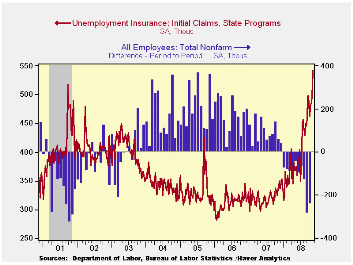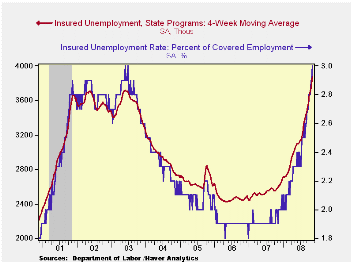 Global| Nov 20 2008
Global| Nov 20 2008U.S. Claims For Jobless Insurance Highest Since 1992
by:Tom Moeller
|in:Economy in Brief
Summary
Rising unemployment caused initial claims for jobless insurance to rise further above 500,000. At 542,000 claims reached their highest level since 1992. But even that comparison, as bad as it is, understates the current degree of [...]

Rising unemployment caused initial claims for jobless insurance to rise further above 500,000. At 542,000 claims reached their highest level since 1992. But even that comparison, as bad as it is, understates the current degree of labor market weakness. The 1992 level above 500,00 was reached for only one week during the short-lived, early-1990's recession. Quickly claims fell back below 400,000. The higher level of claims now is especially troubling since it likely will be sustained for a longer period.
The higher level of claims now is especially disturbing for two reasons. One is that it likely will be sustained for a longer period than one week. The second is that changes to the unemployment insurance program have made it more difficult to be eligible for a claim. Even a lower level of claims now is comparable to a weaker labor market.
Expectations had been for claims last week of 500,000. The four-week moving average of initial claims rose to this cycle's high of 506,500 (52.7% y/y).
The latest level of initial claims for unemployment insurance is for the week which covers the survey period for November nonfarm payrolls. Claims rose 63,000, or 13.2%, from the October period. During the last ten years there has been a 78% (inverse) correlation between the level of initial jobless insurance claims and the monthly change in nonfarm payrolls.
The largest increases in initial claims for the week ending Nov. 8 were in California (+15,532), North Carolina (+6,453), Tennessee (+5,067), New Jersey (+4,706), and New York (+3,680), while the largest decreases were in Kentucky (-1,562), Puerto Rico (-875), Delaware (-751), Maine (-349), and Rhode Island (-335).
Continuing claims for unemployment insurance during the week of November 8 rose by 109,000, about the same as during the prior week during which the level was upwardly revised. The four-week average of continuing claims rose to 3,867,000, this cycle's high and the highest since 1982. Continuing claims provide some indication of workers' ability to find employment and they lag the initial claims figures by one week.
The insured rate of unemployment rose to a new cycle high of 3.0%. The Commerce Department indicated that the highest insured unemployment rates were in Puerto Rico (5.3 percent), Oregon (3.9), California (3.7), Nevada (3.7), Michigan (3.5), Alaska (3.4), Pennsylvania (3.4), South Carolina (3.4), New Jersey (3.3), Arkansas (3.2), and North Carolina (3.2).
The minutes to the latest FOMC meeting can be found here.
| Unemployment Insurance (000s) | 11/15/08 | 11/08/08 | 10/31/08 | Y/Y | 2007 | 2006 | 2005 |
|---|---|---|---|---|---|---|---|
| Initial Claims | 542 | 515 | 484 | 62.8% | 322 | 313 | 331 |
| Continuing Claims | -- | 4,012 | 3,903 | 55.5% | 2,552 | 2,459 | 2,662 |
Tom Moeller
AuthorMore in Author Profile »Prior to joining Haver Analytics in 2000, Mr. Moeller worked as the Economist at Chancellor Capital Management from 1985 to 1999. There, he developed comprehensive economic forecasts and interpreted economic data for equity and fixed income portfolio managers. Also at Chancellor, Mr. Moeller worked as an equity analyst and was responsible for researching and rating companies in the economically sensitive automobile and housing industries for investment in Chancellor’s equity portfolio. Prior to joining Chancellor, Mr. Moeller was an Economist at Citibank from 1979 to 1984. He also analyzed pricing behavior in the metals industry for the Council on Wage and Price Stability in Washington, D.C. In 1999, Mr. Moeller received the award for most accurate forecast from the Forecasters' Club of New York. From 1990 to 1992 he was President of the New York Association for Business Economists. Mr. Moeller earned an M.B.A. in Finance from Fordham University, where he graduated in 1987. He holds a Bachelor of Arts in Economics from George Washington University.






